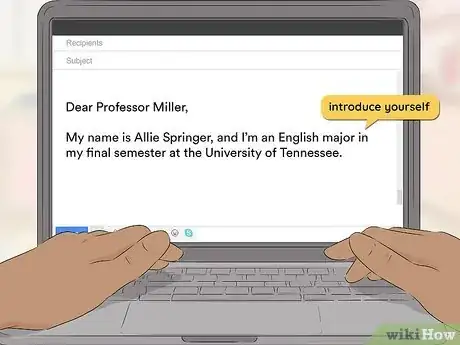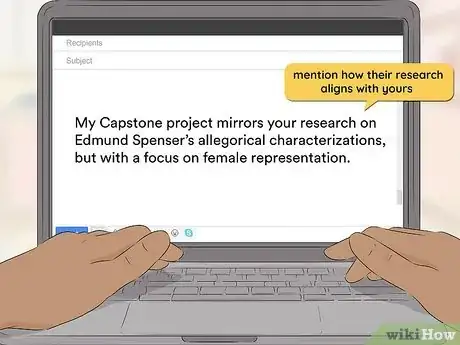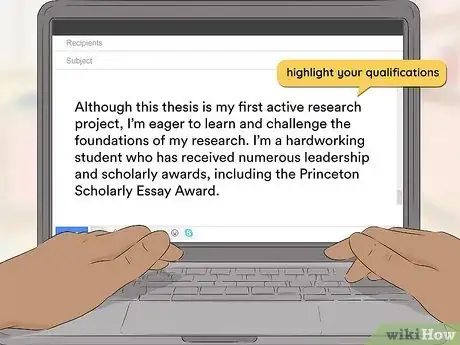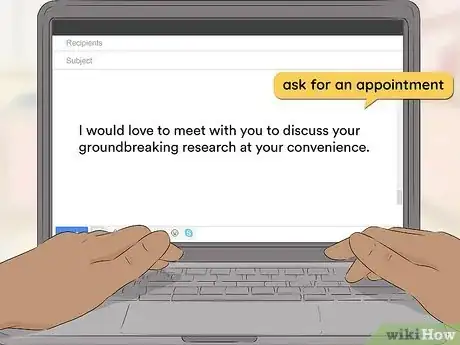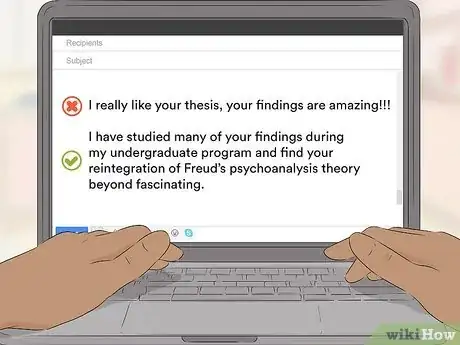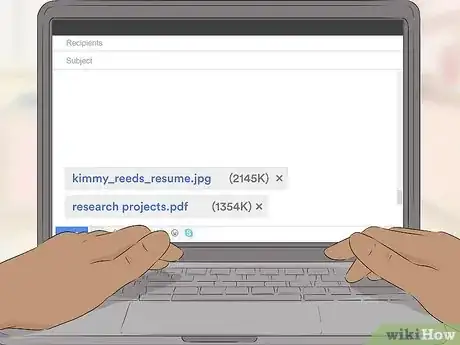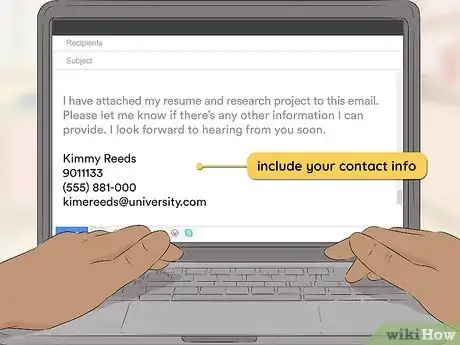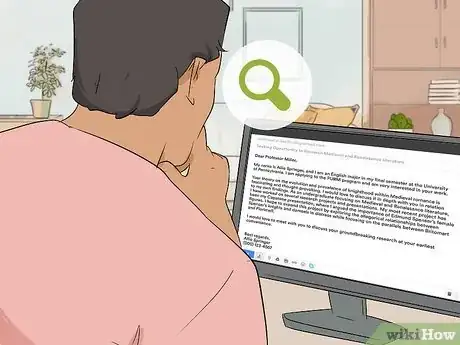This article was co-authored by Alexander Ruiz, M.Ed. and by wikiHow staff writer, Aly Rusciano. Alexander Ruiz is an Educational Consultant and the Educational Director of Link Educational Institute, a tutoring business based in Claremont, California that provides customizable educational plans, subject and test prep tutoring, and college application consulting. With over a decade and a half of experience in the education industry, Alexander coaches students to increase their self-awareness and emotional intelligence while achieving skills and the goal of achieving skills and higher education. He holds a BA in Psychology from Florida International University and an MA in Education from Georgia Southern University.
There are 10 references cited in this article, which can be found at the bottom of the page.
This article has been viewed 10,639 times.
Asking a professor about their research is the first step in gaining a mentor, knowledge, and new opportunities—but how do you do it? Emails are an excellent way to professionally and academically introduce yourself to a professor and express an interest in their expertise. If you don't know the professor well yet, this can seem nerve-wracking, but don't stress! In this article, we’ll tell you everything you need to know about emailing a professor about research and even give you a few examples to work with.
Steps
Best Practice for Emailing Professors
-
1Start with a detailed subject line. Be informative and specific, avoiding vague phrases like “Looking for research mentor.”[1] The subject line should be simple and reflect the content of your email.[2] Here are some examples of a strong email subject line:
- “Meeting to Discuss Biological Engineering for Targeting Cancer Cells”
- “Seeking Opportunity to Research Wollstonecraft’s Gothic Prose”
-
2Introduce yourself. State your full preferred name and education level. Even if the professor knows who you are, it’s nice to keep things formal, especially if you’re asking for their research assistance.[3] [4]
- “My name is Allie Springer, and I’m an English major in my final semester at the University of Tennessee.”
- “My name is Courtney Chaps, and I am currently a sophomore at MIT.”
Advertisement -
3Show you’re familiar with their work. Read up on the professor’s research and academic endeavors before emailing them, and note specific parts that interest you.[5] Browsing the professor’s website and scrolling through their publications are great ways to do this. Try something along the lines of:
- “I have read several of your articles. Your piece on orangutans in National Geographic opened my eyes to a different perspective I am now exploring in my own work.”
- “Your theory on the evolution and prevalence of knighthood within Medieval romance is fascinating and thought-provoking.”
-
4Explain how their research aligns with your goals and passions. This gives you another chance to show how knowledgeable you are about their research while describing your own.[6] Check out these examples:
- “My Capstone project mirrors your research on Edmund Spenser’s allegorical characterizations, but with a focus on female representation.”
- “Your emphasis on the cellular properties of viruses interests me the most because of my extensive history in the medical field.”
-
5Highlight your qualifications and skills. Think of this as a sales pitch. What makes you stand out from other candidates? List awards, challenging coursework, degrees, and anything else that motivates you to learn.[7]
- “Although this thesis is my first active research project, I’m eager to learn and challenge the foundations of my research. I’m a hardworking student who has received numerous leadership and scholarly awards, including the Princeton Scholarly Essay Award.”
- “My first research project focused on leukemia inhibitory factor’s role in cell activation. I have also worked on several experiments related to genetic screening.”[8]
-
6Clearly ask for what you want. State what you're hoping to gain in your correspondence with the professor. If you have to follow a timeline (for instance, if you're only able to work for a particular semester), make sure to mention that. This can be expressed as a question or statement:[9]
- “An apprenticeship with you during the spring semester would allow me to explore my thesis further.”
- “Are there any undergraduate research positions available in your lab?”
-
7Ask for an appointment or mention you’ll stop by during office hours. Don’t be afraid to set your own boundaries and specify when you’re available. Professors will find this admirable, and will appreciate a heads up if you do plan on stopping by their office. Be specific and make sure to include the timezone when addressing meeting times.[10]
- “I would love to meet with you to discuss your groundbreaking research at your convenience.”
- “I am available to meet via Zoom and in-person Mondays through Thursdays from 3 PM to 6 PM PST.”
-
8Use a formal tone. Address the professor by their title and surname. When you introduce yourself, avoid openers and slang like “Hi,” “Hey,” or “What’s up.” Stay away from emojis and abbreviations. Keep things professional and chose a formal goodbye as well, like, “Sincerely,” “Best,” and “Thank you for your time.”[11]
-
9
-
10Include your contact information in the signature. Add a phone number and email below your name so that the professor can contact you for a follow-up. If you have a school ID, that may be nice to include too, especially if you're hoping to be added to this professor’s research team or course.[14] Here’s an example for you to follow:
- “Kimmy Reeds
9011133
(555) 881-000
kimereeds@university.com”
- “Kimmy Reeds
-
11Proofread carefully before sending. Reading your email aloud to yourself or a friend can help you [check for grammar and punctuation mistakes. You can also run the email through an editing software like Grammarly.[15]
-
12Wait for a response. If you don’t get a response in a week, send a follow-up email. Your original email may have gotten lost in their inbox, and sending another shows just how determined you are.[16]
- Try sending the email during the professor’s office hours for a more timely response.
References
- ↑ https://salarship.com/article/email-professor-research-opportunities/
- ↑ https://academicpositions.com/career-advice/how-to-email-a-professor
- ↑ https://research.berkeley.edu/how-cold-email-professor
- ↑ https://www.purdue.edu/advisors/students/professor.php
- ↑ https://sites.psu.edu/gileswriter/2016/08/26/research-opportunity-please-how-to-email-a-professor/
- ↑ https://sites.psu.edu/gileswriter/2016/08/26/research-opportunity-please-how-to-email-a-professor/
- ↑ https://www.chem.purdue.edu/courses/chm49900/CHM499docs/499emailguide.pdf
- ↑ https://biology.nd.edu/assets/182128/example_of_emails_sent_to_a_professor_before_applying.pdf
- ↑ https://www.chem.purdue.edu/courses/chm49900/CHM499docs/499emailguide.pdf
- ↑ https://sites.psu.edu/gileswriter/2016/08/26/research-opportunity-please-how-to-email-a-professor/
- ↑ https://research.ewu.edu/writers_c_writing_email
- ↑ https://research.berkeley.edu/how-cold-email-professor
- ↑ https://sciences.ugresearch.ucla.edu/getting-started/project/
- ↑ https://sciences.ugresearch.ucla.edu/getting-started/project/
- ↑ https://senr.osu.edu/undergraduate/undergraduate-research/dos-and-donts
- ↑ https://sites.psu.edu/gileswriter/2016/08/26/research-opportunity-please-how-to-email-a-professor/

